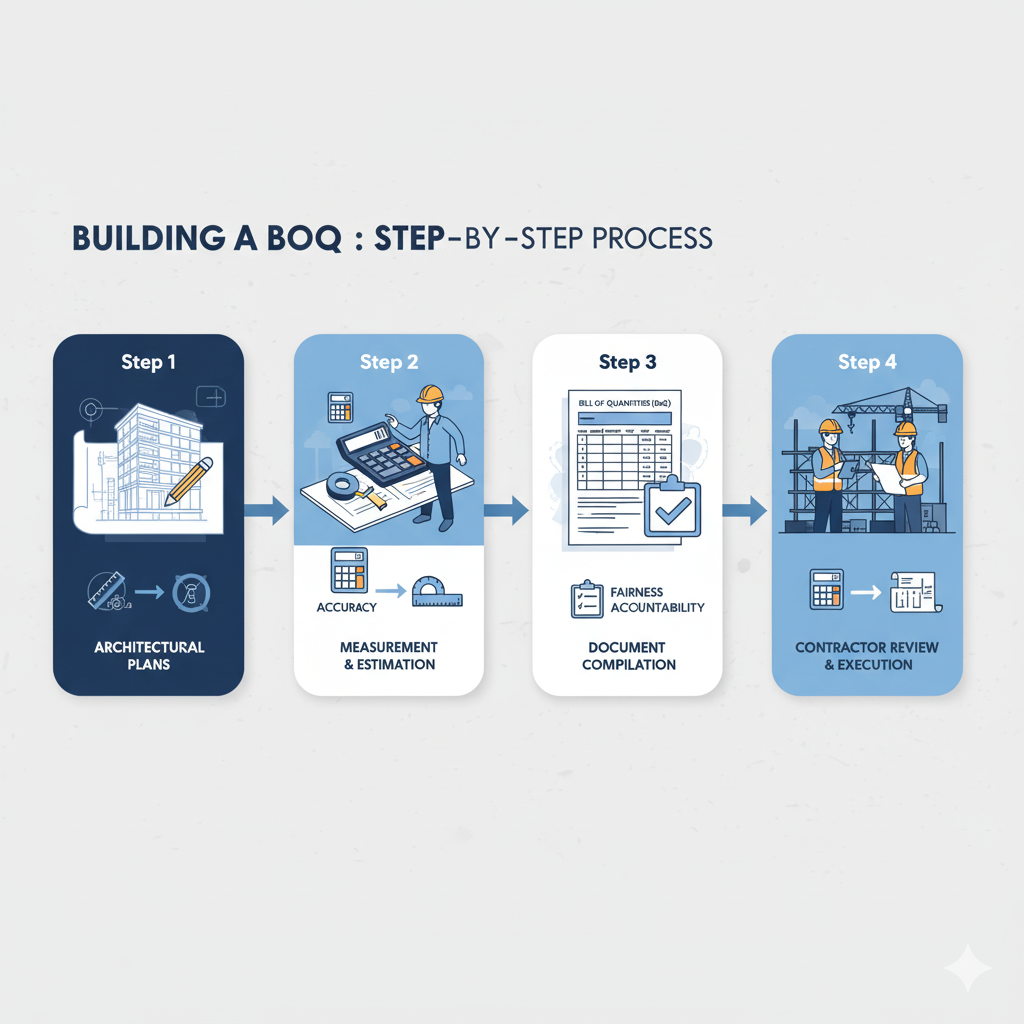Bill of Quantities Explained: 10 Essential Reasons Why BoQ Matters in Construction Projects
In the complex world of construction, precision and clarity are everything. The Bill of Quantities (BoQ) is one of the most important documents in project planning, tendering, and execution. It helps define project scope, standardize pricing, ensure fair competition, and keep costs under control. But what exactly is a Bill of Quantities, and why does it matter so much in construction projects? This article breaks down the concept and explains 10 compelling reasons why every contractor, client, and quantity surveyor should value the BoQ.
Unlocking the Power of a Bill of Quantities
In the fast-paced world of construction, where precision, deadlines, and budgets are everything, having a tool that creates clarity for all parties involved is invaluable. That tool is the Bill of Quantities (BoQ). Yet, many outside the construction industry, and even some professionals within it, still ask:
What is a Bill of Quantities?
A BoQ is not just another document; it is the backbone of successful project planning, tendering, and cost control. Prepared by a qualified quantity surveyor, the BoQ itemises every material, labour cost, and piece of work needed to complete a project. This ensures transparency, facilitates fair competition during tendering, and creates a common ground for contractors, consultants, and clients.
In this article, we’ll break down exactly why a BoQ matters, its step-by-step structure, and its 10 key roles in ensuring construction projects succeed.

What is a Bill of Quantities?
A Bill of Quantities (BoQ) is a detailed document that outlines the quantities and descriptions of materials, parts, and labour required to complete a construction project. It is typically prepared after the design stage and serves as a baseline for cost estimation, tendering, and contract management.
Key features include:
- A breakdown of work sections and trades.
- Standardised descriptions based on industry codes (like CESMM or NRM).
- Itemised quantities, units, and measurement details.
- A framework for pricing by contractors.
Put simply, it’s the “shopping list” of construction, but with far greater accuracy and contractual importance.
Why a Bill of Quantities is Important in Construction Projects
The importance of a Bill of Quantities lies in its ability to eliminate ambiguity, foster transparency, and bring order to what can otherwise become a chaotic process. Whether you are a client trying to secure the best value or a contractor pricing competitively, the BoQ ensures everyone is working with the same baseline.
Without a BoQ, projects risk cost overruns, delays, and disputes. With one, stakeholders benefit from clarity and structure throughout the project lifecycle.
Step-by-Step Guide to Understanding a Bill of Quantities
Understanding how a Bill of Quantities (BoQ) is created and applied throughout the construction cycle helps one fully grasp its importance. A BoQ doesn’t just appear at the start of a project; it follows a systematic process that ensures accuracy, fairness, and accountability for all stakeholders involved.

1. Design Completion
The process begins once architects and engineers finalise the project designs and technical specifications. These detailed drawings form the backbone of the Bill of Quantities and outline every component required to bring the structure to life. Without complete designs, measuring quantities or assigning costs accurately would be impossible. At this stage, clarity in design minimises the risk of costly revisions later in the project.
2. Measurement
Next, a quantity surveyor (QS) carefully measures all elements of the work from the drawings and specifications. This includes areas, volumes, and lengths of construction items such as foundations, walls, roofing, and finishes. Measurement ensures the Bill of Quantities (BoQ) reflects actual construction requirements. By using precise methods, the QS ensures that no essential item is omitted, which reduces the chances of disputes or budget overruns during execution.
3. Compilation
Once quantities are measured, they are organised into structured sections or trades. For instance:
- Substructure and foundations.
- Superstructure (walls, columns, beams).
- Roofing and waterproofing.
- Finishes (plastering, painting, tiling).
- Services (plumbing, electrical, HVAC).
This structured format allows contractors to locate and price individual work items quickly. The organised BoQ also improves efficiency during tender evaluation and later cost monitoring.
4. Standardisation
To ensure consistency and fairness, the work descriptions in a Bill of Quantities (BoQ) follow industry-recognised standards such as the Standard Method of Measurement (SMM) or other local equivalents. Standardisation helps avoid confusion by ensuring all contractors are pricing the same items similarly. This aspect is vital in international projects, where global best practices ensure transparency and comparability across tenders.
5. Tender Use
During the tendering stage, contractors use the Bill of Quantities (BoQ) to insert unit rates and total prices for each measured item. This levels the playing field by ensuring that all bidders work with the same quantities and descriptions. It eliminates guesswork and allows contractors to focus on competitive pricing and efficient resource allocation rather than debating scope.
6. Evaluation
With contractor submissions, the client or project team can compare tenders fairly and transparently. Because all bids are based on identical quantities, the comparison becomes straightforward; differences in pricing reflect each contractor’s efficiency, overheads, and profit margins, not misunderstandings of scope. This ensures the selection of the most competitive yet realistic bid, reducing the risks of disputes later.
7. Contract Integration
Finally, the Bill of Quantities (BoQ) is incorporated into the signed contract. From this point, it becomes a live document for cost monitoring, variation management, and progress payment certification. For example:
- Interim payments are made based on measured work against BoQ items; hence, the client awards the contractor with an Interim Payment Certificate (IPC).
- Variations (changes to design or scope) can be priced more easily, as baseline quantities already exist.
- Quantity surveyors and project managers can track costs against progress, ensuring the project stays within budget.
Why This Matters
This systematic approach highlights the role of the Bill of Quantities (BoQ) in construction contracts and demonstrates why it is such a vital tool for both contractors and clients. The BoQ is their blueprint for cost control and financial management for quantity surveyors. For clients and contractors, it ensures transparency, minimises disputes, and builds trust across all project lifecycle phases.
10 Key Reasons Why a Bill of Quantities Matters in Construction
Before diving into the details, it’s worth noting that the Bill of Quantities (BoQ) is far more than a technical requirement; it is the practical tool that keeps projects on track. Every stakeholder, from clients to contractors and consultants, depends on it for clarity and accountability. Below are ten core reasons why a BoQ is indispensable in ensuring construction projects are delivered on time, within budget, and to the expected quality standards.

1. Accurate Cost Estimation
One of the greatest benefits of a Bill of Quantities in construction is its ability to provide a precise and reliable framework for cost estimation.
- Contractors and cost consultants can base their pricing on standardised, measured quantities rather than guesswork.
- This accuracy helps prevent inflated budgets, hidden costs, or unexpected financial surprises during execution.
- For clients, it creates confidence that funds will be used efficiently and that the project will not stall midway due to miscalculated costs.
Example: On large infrastructure projects such as highways or airports, even minor errors in quantity estimation can lead to multi-million-dollar overruns. A Bill of Quantities (BoQ) minimises this risk.
2. Transparency in Tendering
When a BoQ is provided during the bidding process, it ensures that all contractors are pricing the same scope of work.
- This eliminates the problem of contractors interpreting designs differently, often resulting in incomparable bids.
- Clients benefit from a fair and level playing field, allowing them to evaluate bids on merit rather than guesswork.
- The process builds trust, as contractors know they are being compared fairly against their peers.
The BoQ ensures “apples are compared with apples,” not “apples with oranges.”
3. Effective Budget Control
With clear cost baselines outlined in the Bill of Quantities (BoQ), clients and project managers can keep financial control throughout the construction process.
- Variations (changes to the design or project scope) can be tracked against original quantities, making it easier to see where extra costs arise.
- Escalations in material or labour costs can be measured against the BoQ to understand their impact on overall budgets.
- The BoQ provides a financial roadmap for the entire project, making it possible to forecast expenses more accurately.
This makes it an essential tool for long-term infrastructure projects where cost discipline is critical.
4. Facilitates Contractor Evaluation
Beyond total costs, the Bill of Quantities (BoQ) reveals how contractors distribute their pricing across work items.
- Clients can assess whether a contractor has priced certain sections unusually low (possibly to win the contract but risking future disputes).
- It highlights strengths in resource allocation, efficiency, and procurement strategies.
- Evaluation becomes more comprehensive, helping clients choose the cheapest contractor and the most competent and financially responsible one.
This is vital for public projects where transparency and accountability are legally required.
5. Provides Legal Protection
As part of the contract documents, the Bill of Quantities in tendering has legal weight.
- In the event of disputes over scope, payments, or variations, the BoQ acts as a reference point.
- It clearly defines what quantities and work items were agreed upon at contract signing.
- Courts, arbitration panels, or mediators can rely on the BoQ to settle disputes fairly.
Thus, a Bill of Quantities serves as a safeguard for both clients and contractors.
6. Enhances Communication
The Bill of Quantities (BoQ) provides a common language between architects, engineers, contractors, and clients.
- Each party can refer to the same item descriptions and quantities, avoiding confusion.
- Technical and financial information is consolidated into one document, streamlining communication.
- It reduces misunderstandings that often lead to disputes, delays, or rework.
The BoQ aligns design intent, financial planning, and construction execution.
7. Resource Planning and Procurement
Contractors use the Bill of Quantities (BoQ) not just for pricing but also for planning execution.
- Material procurement schedules can be based directly on quantities provided in the BoQ.
- Labour requirements and machinery needs can be forecast with greater precision.
- Cash flow projections are tied to BoQ items, ensuring contractors allocate resources efficiently.
This prevents project delays caused by poor planning and strengthens overall project delivery.
8. Simplifies Valuations and Payments
During construction, interim valuations and progress payments are tied directly to the BoQ.
- Contractors can claim payments for completed BoQ items, reducing disputes over what has been done.
- Clients benefit from clear and measurable progress, which ensures that interim payment certificates or money are released for actual work rather than estimates.
- It also simplifies the role of the project manager or quantity surveyor in certifying payments.
This mechanism enhances accountability and fairness in payment processes.
9. Helps Quantity Surveyors Execute Their Role
For Quantity Surveyors (QS), the BoQ is the backbone of their profession.
- It allows them to monitor project costs, track financial performance, and report accurately to clients.
- QS professionals can benchmark projects against industry data, improving their advisory role.
- The BoQ provides a structured framework for auditing, ensuring that projects remain financially healthy.
This explains why the importance of the Bill of Quantities is strongly emphasised in quantity surveyor training and professional practice.
10. Supports Post-Project Analysis
Even after project completion, the BoQ remains valuable.
- It provides data for cost analysis and benchmarking against similar projects.
- Lessons learned from the BoQ can inform future project planning and procurement strategies.
- Developers and government agencies can use BoQs from past projects as references for budgeting new infrastructure.
This makes the BoQ a tool for current projects and an investment in knowledge and industry growth.
Advantages of Using a Bill of Quantities for Cost Estimation
The Bill of Quantities (BoQ) is a measurement document and a cornerstone for accurate financial planning in construction projects. The advantages of using a Bill of Quantities for cost estimation extend to every stakeholder, from clients and contractors to consultants and financiers.

Key benefits include:
- Cost Predictability
A BoQ establishes a clear financial framework. Contractors and clients can accurately forecast expenses by providing measured quantities tied to standard rates. This predictability reduces the risk of budgetoverruns, a common challenge in large-scale infrastructure and real estate developments. - Efficient Resource Allocation
The importance of the Bill of Quantities lies in its ability to break down tasks into quantifiable elements. Contractors use these measurements to plan each stage’s workforce, materials, and equipment. This prevents underutilisation or shortages that often delay projects. - Benchmarking Tool for Future Projects
Historic BoQs serve as valuable records. Quantity surveyors and project managers can refer to past BoQs when estimating new projects, improving accuracy over time. This makes BoQs a reference library for the construction industry at large. - Risk Management
The BoQ highlights high-cost items and potential risks early in the project. Stakeholders can create contingency plans by flagging areas prone to overruns (e.g., steel in high-rise projects or concrete in bridges). This proactive approach minimises financial shocks during execution.
The benefits of the Bill of Quantities in construction revolve around financial discipline, efficiency, and foresight, critical ingredients for successful project delivery.
The Role of Bill of Quantities in Construction Contracts
A construction contract without a BoQ is like a map without directions. The role of the Bill of Quantities in construction contracts is pivotal because it provides both structure and legal clarity.
Why it matters in contracts:
- Defines Scope and Pricing Basis
The BoQ clearly outlines the work items, materials, and quantities agreed upon by all parties. This prevents misunderstandings about what the contract covers and what it does not. - Reference for Variations and Claims
Changes in design or scope (known as variations) are inevitable in construction. The BoQ provides a baseline against which these changes are measured, ensuring fair compensation for contractors while protecting clients from inflated claims. - Dispute Resolution Tool
When conflicts arise, the BoQ is a neutral, contractually binding reference. It provides documented proof of agreed quantities and rates in arbitration or court. - Foundation for Payments
Interim valuations and final accounts are typically tied to BoQ items. This means payments can be certified based on completed quantities, ensuring contractors are paid fairly while clients only release funds for actual work done.
This makes the Bill of Quantities in tendering and contracts a safeguard for transparency, fairness, and financial accountability. Without it, construction contracts risk ambiguity and disputes.
Global vs. Local Context: BoQ in Construction
Although the BoQ in construction is a universal tool, its application differs across regions. Variations arise from measurement standards, legal frameworks, and industry practices.

Examples from around the world:
- United Kingdom
The RICS New Rules of Measurement (NRM) guide the UK construction industry. These rules provide standardised procedures for preparing BoQs, ensuring consistency across projects. The system is highly detailed, reflecting the UK’s advanced quantity surveying tradition. - Africa and Asia
Although adaptations exist, many countries follow the Civil Engineering Standard Method of Measurement (CESMM). BoQs are especially important in donor-funded and government projects in developing economies, where accountability is paramount. - Kenya
In Kenya, the Bill of Quantities is mandatory in public and private construction projects. It is tied to tender documentation and contract administration, making it a critical compliance tool. Moreover, before any tendering begins, projects must be registered with the National Construction Authority (NCA).
For further reading, check out NCA Project Registration in Kenya: A Comprehensive Guide.
Key Insight: The global use of BoQs shows their versatility and universal relevance. Whether in skyscraper developments in London, highway projects in Nairobi, or mega infrastructure in Asia, the Bill of Quantities’ importance remains the same: it protects financial interests, supports fairness, and ensures accountability.
Conclusion: Why Every Project Needs a Bill of Quantities
The importance of a Bill of Quantities cannot be overstated. It is not simply a document but the lifeline connecting design, cost, and construction execution. From fair tendering to contract enforcement and cost control, the BoQ ensures that all parties share a transparent, accountable, and structured approach to delivering projects.
For clients, it provides peace of mind. For contractors, it levels the playing field. And for quantity surveyors, it’s the foundation of professional practice. Without a BoQ, construction projects risk confusion, inflated costs, and disputes. With one, success becomes far more achievable.
Call to Action: Take Control of Your Projects with BoQs
If you’re a construction professional, client, or developer, don’t underestimate the power of a well-prepared BoQ. It’s the blueprint for financial clarity, legal certainty, and project success.
Stay updated with more in-depth insights on construction best practices by visiting ConstructionFrontier.com.—your trusted resource for industry knowledge across Africa and beyond.






